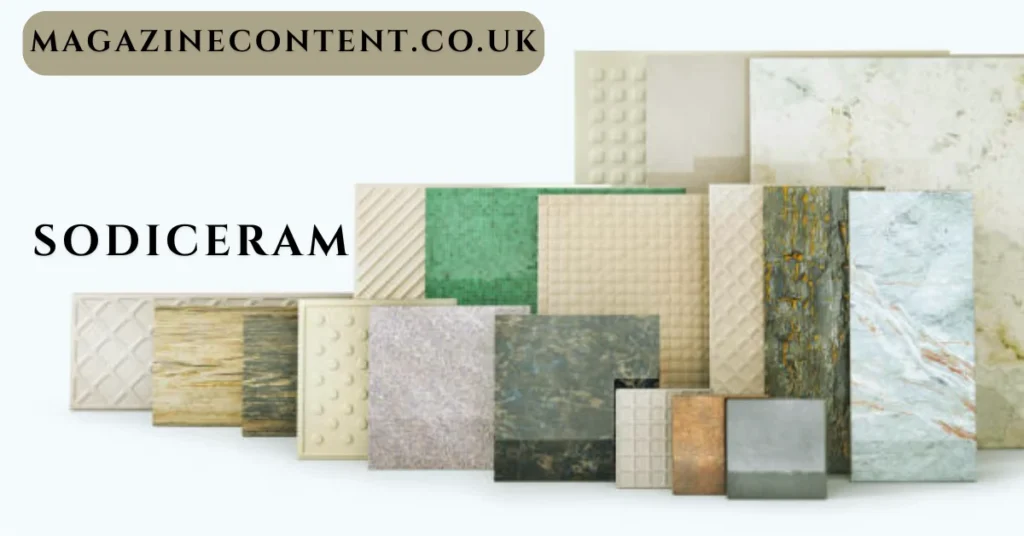Introduction: Rediscovering the Ghost in the Tile
Imagine a hidden algorithm—one not written in Python or etched into silicon, but fired into clay. A quiet, enduring code passed through ceramic tiles, bathroom fixtures, and the very bones of European homes. Its name? Sodiceram.
To the casual observer, Sodicerams was merely a French manufacturer of sanitary ware and ceramics, now a fading name in industrial registries and auction listings. But scratch beneath the glaze, and you’ll find something deeper: a philosophy of craft, a regional economic engine, a design ethic, and perhaps even an early prototype of sustainable industrial identity.
In this sense, Sodiceram is not just a company—it’s a concept. One that threads together questions of material culture, innovation, and what it means to build with purpose in a post-industrial world.
Welcome to the hidden world of Sodiceram.
What Is Sodiceram? A Definition Beyond the Brand
At face value, Sodiceram was a French enterprise involved in the production of tiles, ceramic components, and bathroom fixtures. But when viewed through a more conceptual lens, Sodiceram becomes a symbol—of regional craftsmanship, of dignified utility, and of the tension between industrial mass production and artisanal authenticity.
Sodiceram (n.):
A legacy system of design and production that encapsulates the values of regional identity, sustainable materiality, and elegant functionality in ceramics.
In this definition, Sodiceram operates as a philosophical protocol—an ethos for making things that last, things that matter, things that echo cultural heritage even when the factories fall silent.
Origin: From Earth to Industry to Ideology
Sodiceram’s roots lie in the postwar surge of European industrialism. As France rebuilt its infrastructure, demand for affordable, durable, and aesthetically unified materials exploded. The ceramic tile became a staple—practical, cleanable, and imbued with mid-century optimism.
Emerging from this context, Sodiceram quickly distinguished itself. Based in regions with rich clay deposits and artisanal traditions, the company married local resource economies with modernist design aspirations. But beneath its glossy catalogues and export ambitions was a deeper philosophy: a reverence for place, precision, and permanence.
Sodiceram was, in essence, the Bauhaus of bathroom fittings—form followed function, and function carried culture.
Real-World Applications: Where Sodiceram’s Echo Still Rings
Though the company is no longer active, the Sodiceram ethos persists across sectors:
AI & Algorithmic Design
Just as Sodiceram designed for utility and beauty, contemporary AI is now being trained to mimic human aesthetics in product design. The idea of embedding cultural logic into material forms—central to Sodiceram—foreshadows modern efforts to create emotionally resonant machines and generative design tools.
Business & Supply Chain
Sodiceram sourced and manufactured locally, prefiguring today’s “glocal” models of production that blend global distribution with local fabrication. In a world racing to decentralize supply chains, Sodiceram offers a case study in robust, regionally attuned logistics.
Design & Architecture
Minimalist, geometric, and quietly elegant, Sodiceram tiles influenced more than just bathrooms. Architects now channel this same design vocabulary into sustainable housing, modular furniture, and retro-industrial aesthetics.
Education & Cultural Studies
The fall of Sodiceram provides a rich, untapped narrative for design historians and educators. It embodies a lesson in how objects are not just functional—they are linguistic. They speak of the time, place, and people who birthed them.
YOU MUST READ: Rockford Mesothelioma Lawyer Vimeo: Your Visual Guide to Justice
How Sodiceram Differs: Legacy vs. Protocols vs. Disposable Culture
| Element | Sodiceram | Modern Protocols | Mass Consumerism |
|---|---|---|---|
| Philosophy | Purposeful design rooted in place | Efficiency and interoperability | Scale over soul |
| Production | Regional & sustainable | Modular and global | Outsourced and opaque |
| Aesthetic | Durable elegance | UX-focused utility | Visual overload |
| Cultural Value | Embedded identity | Universal access | Planned obsolescence |
While not a “protocol” in the digital sense, Sodiceram functioned as an analog protocol—governing how resources, design, and regional identity could cohere into a replicable system.
The Future: Sodiceram’s Echo in Tomorrow’s World
As the climate crisis, digital overload, and supply chain volatility reshape industry, the Sodiceram concept becomes strangely relevant.
Ethical Opportunities
- Sustainable Production: Embrace local materials, reduce shipping emissions.
- Cultural Preservation: Reclaim lost crafts and reintegrate them into contemporary design.
- Intergenerational Value: Build things meant to endure, not expire.
Risks of Ignoring the Sodiceram Ethos
- Homogenization: A world designed by algorithms loses its regional flavors.
- Disposable Design: When everything is replaceable, nothing holds meaning.
- Cultural Amnesia: Forgetting how we built in the past means repeating its mistakes without its wisdom.
YOU MUST READ: Rockford Mesothelioma Lawyer Vimeo: Your Visual Guide to Justice
Designing for Sodiceram: Best Practices for Today’s Makers
To bring Sodiceram’s principles into the present, consider these design imperatives:
1. Material Literacy
Understand the properties, histories, and implications of the materials you use.
Think like a potter, not just an engineer.
2. Cultural Anchoring
Infuse your work with local significance. Let geography and community shape your output.
Design with a dialect, not just a dictionary.
3. Longevity Thinking
Plan for decades, not quarters. Prioritize maintainability and repairability.
Design as if someone will inherit your work.
4. Elegant Utility
Strive for beauty that serves function, and function that elevates beauty.
Make the useful poetic.
5. Transparent Craft
Let the process be visible. Share your methods, mistakes, and inspirations.
A good tile tells you how it was made.‘
Conclusion: What the Clay Remembers
Sodiceram is more than a forgotten factory. It’s a ghost embedded in our walls, our sinks, our sense of place. It reminds us that industry need not be soulless, that mass production can carry identity, and that legacy is not measured in profit margins but in cultural resonance.
In a world sprinting toward frictionless everything, Sodiceram is friction—intentional, crafted, embedded with memory. It is a reminder that the future can be built on the past without replicating its mistakes.
The next time you see a plain ceramic tile, ask yourself: What code might be fired into its surface?
YOU MUST READ: 5starsstocks.com Healthcare: The Future of Health Investment
FAQs
What was Sodiceram?
Sodiceram was a French company known for making ceramic tiles and bathroom products. It’s no longer active but left a strong design legacy.
Why is Sodiceram important today?
It represents a way of making things with care, using local materials and long-lasting designs—something we’re trying to relearn now.
Was Sodiceram just a brand or a movement?
While it was a brand, its design philosophy and regional focus make it more like a hidden design movement.
Can modern companies use Sodiceram’s approach?
Yes! By making sustainable, well-crafted, and culturally rooted products, companies can follow Sodiceram’s example.
What can designers learn from Sodiceram?
Designers can learn to make things that are both useful and beautiful, grounded in real places and meant to last.






